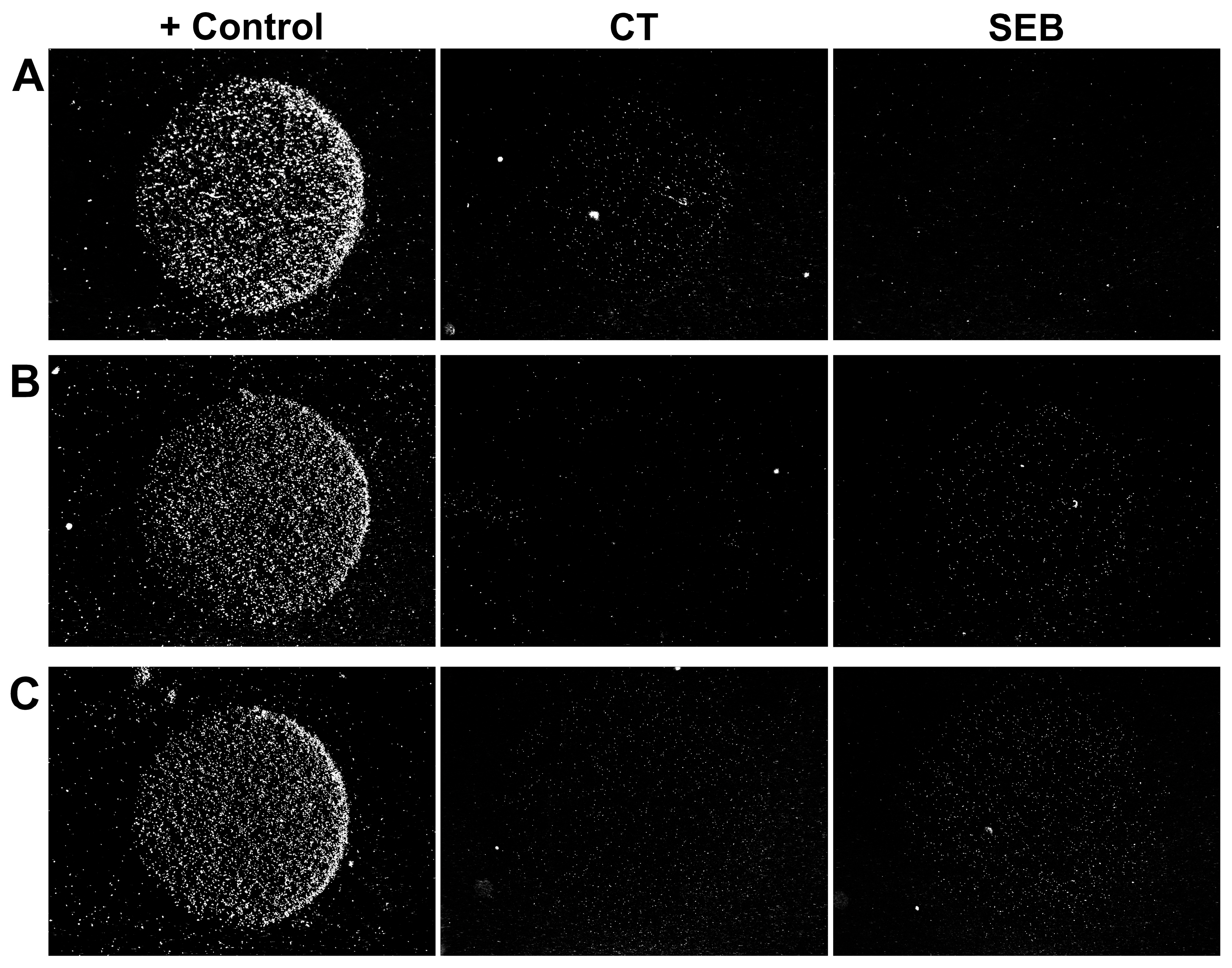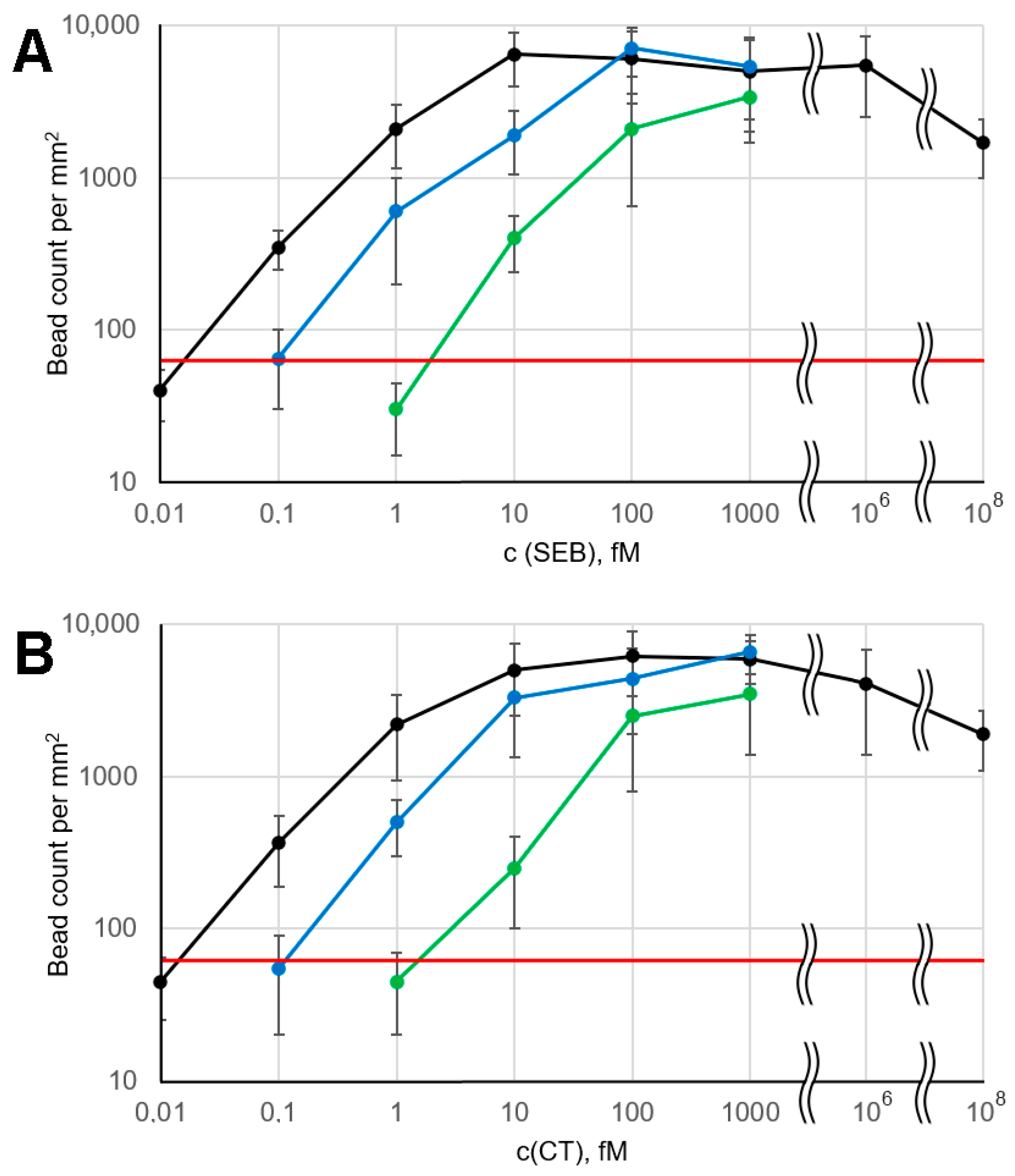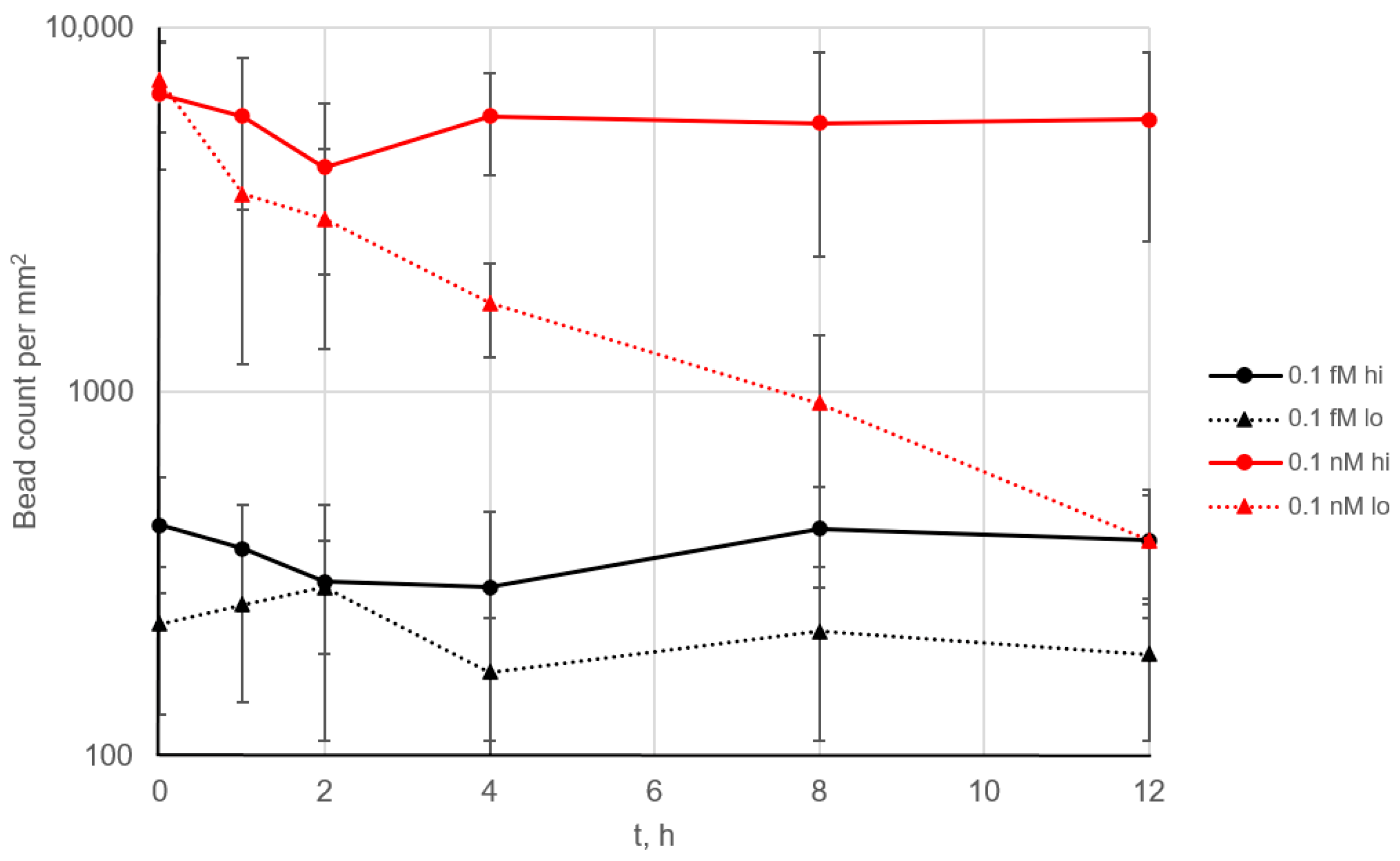Ultrasensitive Bead-Based Immunoassay for Real-Time Continuous Sample Flow Analysis
Abstract
1. Introduction
2. Materials and Methods
2.1. Materials and Chemicals
2.2. Design of Electrophoretic Flow Cell
2.3. Microarray Fabrication
2.4. Assay Procedure
2.5. Image Processing and Statistical Analysis
3. Results and Discussion
3.1. Design of Electrophoretic Flow Cell and Experimental Setup
3.2. Assay Parameters
3.3. Detection of Individual Toxins
3.4. Multiplex Assay
3.5. Calibration Curves and Electrophoresis Effect
3.6. Real-Time Online Sample Monitoring for Biomarkers of Bacterial Pathogens
4. Conclusions
Supplementary Materials
Author Contributions
Funding
Institutional Review Board Statement
Informed Consent Statement
Data Availability Statement
Conflicts of Interest
Abbreviations
| CT | Cholera toxin |
| SEB | Staphylococcal enterotoxin B |
| LOD | Limit of detection |
| FFD | Fluidic force discrimination |
References
- Poudineh, M.; Maikawa, C.L.; Ma, E.Y.; Pan, J.; Mamerow, D.; Hang, Y.; Baker, S.W.; Beirami, A.; Yoshikawa, A.; Eisenstein, M.; et al. A fluorescence sandwich immunoassay for the real-time continuous detection of glucose and insulin in live animals. Nat. Biomed. Eng. 2021, 5, 53–63. [Google Scholar] [CrossRef] [PubMed]
- Ferguson, B.S.; Hoggarth, D.A.; Maliniak, D.; Ploense, K.; White, R.J.; Woodward, N.; Hsieh, K.; Bonham, A.J.; Eisenstein, M.; Kippin, T.E.; et al. Real-time, aptamer-based tracking of circulating therapeutic agents in living animals. Sci. Transl. Med. 2013, 5, 213ra165. [Google Scholar] [CrossRef] [PubMed]
- Arroyo-currás, N.; Somerson, J.; Vieira, P.A.; Ploense, K.L.; Kippin, T.E.; Plaxco, K.W. Real-time measurement of small molecules directly in awake, ambulatory animals. Proc. Natl. Acad. Sci. USA 2017, 114, 645–650. [Google Scholar] [CrossRef]
- Li, T.; Li, S.; Shi, J.; Liu, J.; Yang, H.; Wu, W.; Zhao, L.; Zhao, Z. Real-time analysis of metabolites in vivo by online extraction electrospray ionization mass spectrometry coupled to microdialysis. Anal. Chim. Acta 2022, 1205, 339760. [Google Scholar] [CrossRef]
- Wang, H.; Tang, J.; Wan, X.; Wang, X.; Zeng, Y.; Liu, X.; Tang, D. Mechanism Exploration of the Photoelectrochemical Immunoassay for the Integration of Radical Generation with Self-Quenching. Anal. Chem. 2024, 96, 15503–15510. [Google Scholar] [CrossRef]
- Kleymenov, D.A.; Shchannikova, M.P.; Rudenko, N.A.; Karatovskaya, A.P.; Shepelyakovskaya, A.O.; Zamyatina, A.V.; Boziev, K.M.; Oleinikov, V.A.; Noskov, A.N.; Tkachuk, A.P.; et al. Development and validation of a multiplex bead-based immunoassay for the simultaneous detection of fifteen pathogenic biological agents. Microchem. J. 2024, 203, 110923. [Google Scholar] [CrossRef]
- Barhoumi, L.; Bellagambi, F.G.; Vivaldi, F.M.; Baraket, A.; Clément, Y.; Zine, N.; Ali, M.B.; Elaissari, A.; Errachid, A. Ultrasensitive Immunosensor Array for TNF-α Detection in Artificial Saliva using Polymer-Coated Magnetic Microparticles onto Screen-Printed Gold Electrode. Sensors 2019, 19, 692. [Google Scholar] [CrossRef]
- Zhang, T.; Wu, H.; Qiu, C.; Wang, M.; Wang, H.; Zhu, S.; Xu, Y.; Huang, Q.; Li, S. Ultrasensitive Hierarchical AuNRs@SiO2@Ag SERS Probes for Enrichment and Detection of Insulin and C-Peptide in Serum. Int. J. Nanomed. 2024, 19, 6281–6293. [Google Scholar] [CrossRef]
- Wang, H.; Fang, X.; Wang, Y.; Zhang, Y.; Lin, R.; Ou, F.; Gu, H.; Xu, H. Improving the sensitivity of a multiplexed digital immunoassay based on extremely high bead analysis efficiency. ACS Sens. 2025, 10, 1289–1297. [Google Scholar] [CrossRef]
- Mulvaney, S.P.; Myers, K.M.; Sheehan, P.E.; Whitman, L.J. Attomolar protein detection in complex sample matrices with semi-homogeneous fluidic force discrimination assays. Biosens. Bioelectron. 2009, 24, 1109–1115. [Google Scholar] [CrossRef]
- Tekin, H.C.; Cornaglia, M.; Gijs, M.A.M. Attomolar protein detection using a magnetic bead surface coverage assay. Lab. Chip 2013, 13, 1053–1059. [Google Scholar] [CrossRef] [PubMed]
- Edelstein, R.L.; Tamanaha, C.R.; Sheehan, P.E.; Miller, M.M.; Baselt, D.R.; Whitman, L.J.; Colton, R.J. The BARC biosensor applied to the detection of biological warfare agents. Biosens. Bioelectron. 2000, 14, 805–813. [Google Scholar] [CrossRef] [PubMed]
- Cornaglia, M.; Trouillon, R.; Tekin, H.C.; Lehnert, T.; Gijs, M.A.M. Magnetic particle-scanning for ultrasensitive immunodetection on-chip. Anal. Chem. 2014, 86, 8213–8223. [Google Scholar] [CrossRef] [PubMed]
- Morozov, V.N.; Morozova, T.Y. Electrophoresis-assisted active immunoassay. Anal. Chem. 2003, 75, 6813–6819. [Google Scholar] [CrossRef]
- Morozov, V.N.; Groves, S.; Turell, M.J.; Bailey, C. Three minutes-long electrophoretically assisted zeptomolar microfluidic immunoassay with magnetic beads detection. J. Am. Chem. Soc. 2007, 129, 12628–12629. [Google Scholar] [CrossRef]
- Khnouf, R.; Goet, G.; Baier, T.; Hardt, S. Increasing the sensitivity of microfluidics based immunoassays using isotachophoresis. Analyst 2014, 139, 4564–4571. [Google Scholar] [CrossRef]
- Shlyapnikov, Y.M.; Shlyapnikova, E.A.; Simonova, M.A.; Shepeliakovskaya, A.O.; Brovko, F.A.; Komaleva, R.L.; Grishin, E.V.; Morozov, V.N. Rapid simultaneous ultrasensitive immunodetection of five bacterial toxins. Anal. Chem. 2012, 84, 5596–5603. [Google Scholar] [CrossRef]
- Morozov, V.N.; Morozova, T.Y. Active bead-linked immunoassay on protein microarrays. Anal. Chim. Acta 2006, 564, 40–52. [Google Scholar] [CrossRef]
- Zhou, Q.; Lin, Y.; Zhang, K.; Li, M.; Tang, T. Reduced graphene oxide/BiFeO3 nanohybrids-based signal-on photoelectrochemical sensing system for prostate-specific antigen detection coupling with magnetic microfluidic device. Biosens. Bioelectron. 2018, 101, 146–152. [Google Scholar] [CrossRef]
- Rubina, A.Y.; Filippova, M.A.; Feizkhanova, G.U.; Shepeliakovskaya, A.O.; Sidina, E.I.; Boziev, K.M.; Laman, A.G.; Brovko, F.A.; Vertiev, Y.V.; Zasedatelev, A.S.; et al. Simultaneous Detection of Seven Staphylococcal Enterotoxins: Development of Hydrogel Biochips for Analytical and Practical Application. Anal. Chem. 2010, 82, 8881–8889. [Google Scholar] [CrossRef]
- Petrova, E.E.; Komaleva, R.L.; Lakhtina, O.E.; Samokhvalova, L.V.; Kalinina, N.A.; Shoshina, N.S.; Rubina, A.Y.; Filippova, M.A.; Vertiev, Y.V.; Valyakina, T.I.; et al. Preparation and Characterization of Monoclonal Antibodies to the Cholera Toxin. Russ. J. Bioorg. Chem. 2009, 35, 326–334. [Google Scholar] [CrossRef] [PubMed]
- Shlyapnikov, Y.M.; Morozov, V.N.; Shlyapnikova, E.A. Carboxymethyl cellulose film as a substrate for microarray fabrication. Anal. Chem. 2014, 86, 2082–2089. [Google Scholar] [CrossRef] [PubMed]
- Morozova, T.Y.; Morozov, V.N. Force differentiation in recognition of cross-reactive antigens by magnetic beads. Anal. Biochem. 2008, 374, 263–271. [Google Scholar] [CrossRef]
- Shlyapnikov, Y.M.; Morozov, V.N. Titration of trace amounts of immunoglobulins in a microarray-based assay with magnetic labels. Anal. Chim. Acta 2017, 966, 47–53. [Google Scholar] [CrossRef]
- Shlyapnikov, Y.M.; Kanev, I.L.; Shlyapnikova, E.A. Rapid ultrasensitive gel-free immunoblotting with magnetic labels. Anal. Chem. 2020, 92, 4146–4153. [Google Scholar] [CrossRef]
- Jachimska, B.; Pajor, A. Physico-chemical characterization of bovine serum albumin in solution and as deposited on surfaces. Bioelectrochemistry 2012, 87, 138–146. [Google Scholar] [CrossRef]
- Simonova, M.A.; Valyakina, T.I.; Petrova, E.E.; Komaleva, R.L.; Shoshina, N.S.; Samokhvalova, L.V.; Lakhtina, O.E.; Osipov, I.V.; Philipenko, G.N.; Singov, E.K.; et al. Development of xMAP assay for detection of six protein toxins. Anal. Chem. 2012, 84, 6326–6330. [Google Scholar] [CrossRef]
- Rathod, V.; Kadam, L.; Gautam, M.; Gumma, P.D.; Marke, K.; Asokanathan, C.; Douglas-Bardsley, A.; Hassell, L.; Bhandare, S.; Gupta, S.; et al. Multiplexed bead-based assay for the simultaneous quantification of human serum IgG antibodies to tetanus, diphtheria, pertussis toxin, filamentous hemagglutinin, and pertactin. Front. Immunol. 2023, 14, 1190404. [Google Scholar] [CrossRef]
- Zhang, Y.; Kuang, X.; Yi, J.; Sun, T.; Guo, O.; Gu, H.; Xu, H. Revolutionizing the capture efficiency of ultrasensitive digital ELISA via an antibody oriented-immobilization strategy. J. Mater. Chem. B 2024, 12, 10041–10053. [Google Scholar] [CrossRef]
- Liu, S.; Zhang, H.; Dai, J.; Hu, S.; Pino, I.; Eichinger, D.J.; Lyu, H.; Zhu, H. Characterization of monoclonal antibody’s binding kinetics using oblique-incidence reflectivity difference approach. mAbs 2015, 7, 110–119. [Google Scholar] [CrossRef]
- Sheehan, P.E.; Whitman, L.J. Detection limits for nanoscale biosensors. Nano Lett. 2005, 5, 803–807. [Google Scholar] [CrossRef] [PubMed]
- Kinnunen, P.; Sinn, I.; McNaughton, B.H.; Newton, D.W.; Burns, M.A.; Kopelman, R. Monitoring the growth and drug susceptibility of individual bacteria using asynchronous magnetic bead rotation sensors. Biosens. Bioelectron. 2011, 26, 2751–2755. [Google Scholar] [CrossRef] [PubMed]
- Gong, H.; Cradduck, M.; Cheung, L.; Michael Olive, D. Development of a near-infrared fluorescence ELISA method using tyramide signal amplification. Anal. Biochem. 2012, 426, 26–29. [Google Scholar] [CrossRef] [PubMed]
- Shepelyakovskaya, A.O.; Rudenko, N.V.; Karatovskaya, A.P.; Shchannikova, M.P.; Shulcheva, I.; Fursova, K.K.; Zamyatina, A.V.; Boziev, K.M.; Oleinikov, V.A.; Brovko, F.A. Development of a Bead-Based Multiplex Assay for the Simultaneous Quantification of Three Staphylococcal Enterotoxins in Food by Flow Cytometry. Food Anal. Methods 2020, 13, 1202–1210. [Google Scholar] [CrossRef]
- Hwang, J.; Lee, S.; Choo, J. Application of a SERS-based lateral flow immunoassay strip for rapid and sensitive detection of staphylococcal enterotoxin B. Nanoscale 2016, 8, 11418–11425. [Google Scholar] [CrossRef]
- Normandeau, F.; Ng, A.; Beaugrand, M.; Juncker, D. Spatial Bias in Antibody Microarrays May Be an Underappreciated Source of Variability. ACS Sens. 2021, 6, 1796–1806. [Google Scholar] [CrossRef]




Disclaimer/Publisher’s Note: The statements, opinions and data contained in all publications are solely those of the individual author(s) and contributor(s) and not of MDPI and/or the editor(s). MDPI and/or the editor(s) disclaim responsibility for any injury to people or property resulting from any ideas, methods, instructions or products referred to in the content. |
© 2025 by the authors. Licensee MDPI, Basel, Switzerland. This article is an open access article distributed under the terms and conditions of the Creative Commons Attribution (CC BY) license (https://creativecommons.org/licenses/by/4.0/).
Share and Cite
Shlyapnikov, Y.M.; Shlyapnikova, E.A. Ultrasensitive Bead-Based Immunoassay for Real-Time Continuous Sample Flow Analysis. Biosensors 2025, 15, 316. https://doi.org/10.3390/bios15050316
Shlyapnikov YM, Shlyapnikova EA. Ultrasensitive Bead-Based Immunoassay for Real-Time Continuous Sample Flow Analysis. Biosensors. 2025; 15(5):316. https://doi.org/10.3390/bios15050316
Chicago/Turabian StyleShlyapnikov, Yuri M., and Elena A. Shlyapnikova. 2025. "Ultrasensitive Bead-Based Immunoassay for Real-Time Continuous Sample Flow Analysis" Biosensors 15, no. 5: 316. https://doi.org/10.3390/bios15050316
APA StyleShlyapnikov, Y. M., & Shlyapnikova, E. A. (2025). Ultrasensitive Bead-Based Immunoassay for Real-Time Continuous Sample Flow Analysis. Biosensors, 15(5), 316. https://doi.org/10.3390/bios15050316




